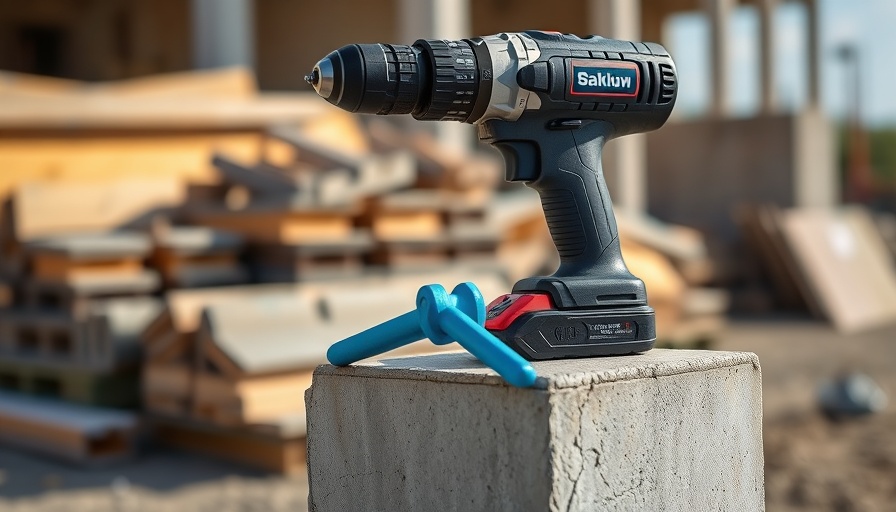
The Right Tools: Key to Successful Concrete Anchoring
Securing objects to concrete can be daunting, especially for homeowners attempting DIY projects. In the informative video titled "You're Doing It Wrong! | Why Most Homeowners Fail With Concrete Anchors", Scott from Everyday Home Repairs highlights the common pitfalls and how to approach concrete anchoring successfully. The critical takeaway is that having the right tools—not just any drill—can make all the difference between a frustrated DIY experience and a successful project.
In 'You're Doing It Wrong! | Why Most Homeowners Fail With Concrete Anchors', Scott dives into common mistakes and successful techniques for securing attachments to concrete, prompting us to explore the practical insights shared in this piece.
Avoid Common Mistakes When Choosing Anchors
Many homeowners unwittingly choose the wrong type of concrete anchor, which can lead to costly failures. In the video, Scott reveals a poll he conducted with thousands of homeowners regarding their preferred anchoring methods. Surprisingly, only 10% favored the innovative Simpson Strong-Tie Titan series. In contrast, more than half relied on less reliable options, such as Tapcons, which can be prone to blowouts. Scott confidently asserts that the Titan series, thanks to its unique thread design, provides superior grip and resilience.
The Drill Decision: Hammer Drill vs. Rotary Hammer
An essential aspect of successfully anchoring to concrete is the type of drill used. Many homeowners opt for a standard combination drill and rely on its hammer function, thinking it will suffice. However, Scott stresses that these would only serve well for a couple of holes. For larger projects—like his 16-hole endeavor—investing in a rotary hammer drill is vital. This powerful tool can drill through concrete significantly faster and with less physical strain. Scott’s demonstration, reporting a fourfold increase in drilling speed, highlights how critical the right drill is in avoiding unnecessary frustration.
The Importance of Clean Holes
A less obvious but crucial factor in successful anchoring is the cleanliness of the drilled holes. When drilling, debris can accumulate in the hole, which Scott notes can lead to anchor failure. He recommends drilling deeper than the anchor's length to ensure room for any debris and using a vacuum to keep the space clear. By maintaining a clean hole, homeowners can bolster the reliability of their concrete anchors and ultimately save time and money on potential repairs.
Choosing the Right Fasteners Saves Time
After discussing drilling techniques and tools, Scott emphasizes the importance of selecting high-quality fasteners. In his experience, the Simpson Strong-Tie Titan HD anchors consistently delivered strong results without the risk of blowouts. It’s tempting to go for those available at lower prices, but that risk is not worth the savings when the integrity of your project relies on solid anchors. Quality products lead to durability, while quality processes lead to reliability.
Conclusion: Mastering Concrete Anchoring for Future Projects
As Scott expertly guides viewers through the nuances of anchoring to concrete, it's clear that understanding the tools and techniques can significantly enhance the success of DIY projects. By choosing the right products, using a suitable drill, and ensuring clean holes, homeowners can conquer concrete anchoring challenges with confidence. As you embark on your next home project, remember these insights to avoid common pitfalls and achieve lasting results.
Some Frequently Asked Questions about Concrete Anchors
Q: What are the best anchors to use for heavy objects?
A: For heavy objects, consider utilizing the Simpson Strong-Tie Titan series as they provide stronger holding capabilities compared to standard options.
Q: Can I use a standard drill instead of a rotary hammer?
A: While a standard drill is sufficient for light tasks, it’s advisable to invest in a rotary hammer drill for projects involving multiple holes in concrete.
Q: How do I clean the hole after drilling?
A: Use a vacuum while drilling to clear out debris and ensure that the hole is clean before inserting the anchor.
 Add Row
Add Row  Add
Add 




Write A Comment